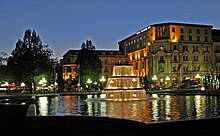Hotel Nassauer Hof Wiesbaden

The Hotel Nassauer Hof in the Hessian capital Wiesbaden is one of the largest grand hotels in the world. In 2005 it was the first hotel in Germany to be included in the 5-star superior class of the German hotel classification . The hotel is a member of The Leading Hotels of the World Association and a selection of German luxury hotels .
The Ente restaurant in the hotel has been awarded a Michelin star without interruption since 1980 , and has been under the management of chef Michael Kammermeier since 2006 . The Nassauer Hof has 135 rooms, 23 suites and one presidential suite . In addition, the hotel has a swimming pool that is fed by its own thermal spring , the mirror spring.
location
The hotel is located at Kaiser-Friedrich-Platz 3-4 in Wiesbaden , directly on Wilhelmstrasse and opposite the Kurhaus colonnades and the bowling green . The Kurhaus and the Hessian State Theater , the Kurpark and the Wiesbaden Park Warmer Damm are in the immediate vicinity .
history
The history of the house began in 1813, when the innkeeper Johann Freinsheim opened the German House , whose name he changed to Hotel Nassau three years later . In 1819 the Johann Friedrich Goetz family bought the building and had it lavishly redesigned in classical forms.
In 1827 the new ducal court theater was opened in the immediate vicinity of the hotel , from which the Goetz family also benefited. When the rail link to Frankfurt am Main was opened in 1840 , guests of the up-and-coming spa town of Wiesbaden could travel comfortably by train. The city, which soon called itself "world spa town", experienced a great boom. Numerous guests came to the glamorous spa , including the Russian writer Fyodor M. Dostojewski , who stayed at the Hotel Nassau, gambled away all his money in the casino and out of this necessity wrote the novel The Gambler , in which Wiesbaden lives on as a roulette castle.
In 1866 the Duchy of Nassau , which was on Austria's side in the German War , was annexed by the victorious Prussians . The duke was chased out of the city palace and the Prussian kings and later German emperors then used the palace for their numerous stays in the city. Also due to the numerous visits of the emperor, the city developed an enormous attraction and had the most millionaires in Germany at the turn of the century. Numerous new buildings were erected, including the theater (1894) and the new Kurhaus (1907) in the immediate vicinity of the Hotel Nassau. In 1897 Kaiser Wilhelm II inaugurated a monument to his father right in front of the Hotel Nassauer Hof , as the house was now called. In the same year, the adjacent court theater was integrated into the hotel complex.
In 1903 the hotel witnessed an encounter between Kaiser Wilhelm II and Tsar Nikolaus II. In 1907, the new Kurhaus was inaugurated within sight, while the hotel was equipped with a Wilhelmine facade and renovated. It now had 200 lavishly appointed rooms and a luxurious thermal bath.
In 1917 the family tradition came to an end. After the First World War , the Mülheim merchant Hugo Stinnes bought the hotel from the Goetz family. During the Second World War , the hotel burned down completely; Reconstruction by architect Ernst Neufert began in 1950 , financed by Stinnes . Since 2001 the Hotel Nassauer Hof has belonged to a group of investors that founded an operating company.
Famous guests
- Fyodor Michailowitsch Dostoevsky 1865
- Kaiser Wilhelm II. 1897/1903
- Tsar Nicholas II. 1903
- Walther Rathenau and Louis Loucheur in 1921 in the negotiations for the Wiesbaden Agreement
- Paul von Hindenburg 1930
- John F. Kennedy in June 1963
- Richard Nixon
- Audrey Hepburn
- Luciano Pavarotti
- Reinhold Messner
- Dalai Lama in July 2005
- Vladimir Putin in October 2007
- Willem-Alexander in June 2013
Individual evidence
- ↑ nassauer-hof.de: duck
- ↑ Hochheim city announcement . August 30, 1921.
- ^ Report of the Frankfurter Rundschau
- ^ Report by the Wiesbadener Kurier ( Memento from June 7, 2013 in the Internet Archive )
Web links
Coordinates: 50 ° 5 ′ 6 ″ N , 8 ° 14 ′ 38.6 ″ E




